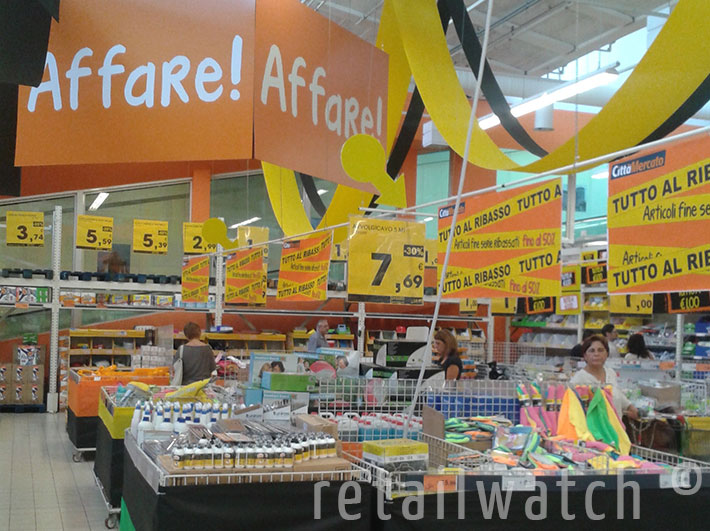
Citta’Mercato-Catania: l’ipermkt di vicinato.
October 2014. Area greater than 2,500 square meters, easy accessibility, lack of attractiveness in non-food (instead of the typical traditional hypermarkets), usability particular centralized on food, broad assortment and not deep.
"Heart of vigorous discount store, rugged button in the chest of a hypermarket".
These can be, respectively, definition and image useful to identify the special format designed by Auchan for the territory of Catania.
It bears the name “Città Mercato” and it is the hypermarket neighborhood, a new concept.
The context of the city has over 300,000 inhabitants, is one of the fifteen metropolitan cities, is in tenth position in Italy as a municipal population; Catania is the Italian town, not the Regional Capital, the most populous of all.
These figures confirm the size and importance of the basin, justifying the strategy of experimenting on this fertile piece of land an original format, unique in its particularity.
A closer look, the location allows, on the whole, approximately 513,000 people to be able to reach the point of sale within 25 minutes; over 102,000 are those that instead it might do in a time interval much smaller (5 minutes).

Auchan has decided to keep the name “Città Mercato” to continue to enjoy the resonance that it held this territory in the past.
Nevertheless changed in a radical way the guidelines of trade policy and the focus has been with determination towards a project that could realize the potential of the large and the service by means of logic and philosophy "discount".
The experiment is in progress, but it seems to work.
The store, as it is now operating, has started work on November 29, 2013 (not yet completed the first year of employment).
Below, in detail, some of the data:
- 22 cash desks (ten of them in "self");
- 5.800 square meters of sales;
- about 1,000 square meters used for the storage area;
- 1,800 parking spaces;
- target of annual turnover of 25 million Euro;
- assortment consists of approximately 16,000 items, of which 14,000 in feeding (with 20% of localism) and 2,000 in the non-food;
- about 2,300 customers a day (with peaks exceeding abundantly during Saturdays and Public holiday opening);
- € 22.00, average receipt;
- 18%, average margin;
- frequently purchased consumer about 3 steps per week;
- fruit and vegetables which fund with a higher incidence on total sales by average penetration of 47% (about 1 out of 2 customers buy in the department).
There is ample parking, a thick barrier with cash desks to imposing support of nearly 6,000 square meters of sales and worthily equipped to deal with queues of customers through ten stations in "self-scanning", it aims to make 25 million euros. All this translates into a batting average cash from 22 Euro, with a customer base that performs 2/3 visits per week, in a repetitive frequency of purchase more than that of traditional hypermarkets and similar to that of classic neighborhood supermarkets.

Assorted food but not only.
The proposal focuses primarily on commercial food categories, represented by 87% in a global commodity spectrum broad enough but shallow, except for perfumes, pet food and accessories especially for the car, which is considered one of the best stocked the entire Sicily.
Fruit and vegetables is located near the entrance, according to the presentation impressive and standardized, as in the style of the best supermarkets, but atypical location for a hypermarket (in the classical ones is usually at the end of the path).
The point of sale appears as a dynamic that moves between two poles assured, identified in the convenience and quality of fresh.
The response of the consumer with regard to the aspect of quality seems good, considering the penetration rate of the produce department (47%) and frequency of purchase, indicate that repeated passages well, hardly admissible without the use of products such as bread, fruit, vegetables, meat, fish, meats, or items the sale of which is able to report consolidated purchasing habits, trust and consensus on quality by consumers.
From international to local.
Significant, in this sense, was the ability of a company distribution, a renowed multinational company, to attract consumers strongly associated with traditional shopping experiences, accrued with bakers, fishmongers, butchers, fruit and vegetable markets and food shops of confidence (socio-economic profile mainly linked to the south).
The fundamental aspect of convenience is based on the careful work of monitoring the competition of the square, which results in a positioning trend 100 on the competitor that has the lowest price.
The competitors are Ipercoop Sicilia, Spaccio Alimentare, Iperfamila.
By way of example, with reference to industry brand:
Pasta BARILLA 500 grams € 0.74;
Oil extra virgin "classico" MONINI 1 liter € 5.69;
COCA COLA (COKE) 1.5 liters € 1.59
The consistency of the commitment is strengthened by a communication to the "welcome box" that reads: "Within 7 days from the date of purchase, we will refund you 10 times the difference of the higher price that we practiced over another selling price".
This is obviously a promise binding, balanced by further specifications to make it financially sustainable over time: "The reimbursement is made only on foods, with the exception of the following departments: fruit and vegetables, butcher, fishmonger, bakery, pastries, deli stand, cheese stand", "The maximum amount payable for receipt is 10 Euro for a maximum of 10 units purchased (household consumption)".
Are not practiced regular promotional events with the catalogs (except for institutional communications issued twice a month, in which there are lowered sales prices, but include some opportunities for continuing suitability, representing an assortment that has low price throughout the year), the " wide promotional area at the entrance to the store" is occupied according to the seasonality of the moment.

There are no institutional loyalty programs, apart from a systematic and consistent with the intended purposes, carried out on a daily basis.
Indeed, the difficulties can arise opportunities.
Città Mercato was a sign known, but in a crisis.
Auchan has handled the problems, has changed the format, the philosophy has approached the discount at an appropriate time, has retained the essential characteristics of quality and service, planned and realized substantial cost savings publishing, distribution and negotiation of promotions and has proceeded to reinvest all on a proposal highly attractive to quality and price, at any time of the year.
In broadest outline:
Strengths:
- Location
- New concept
- Innovation
- Non food calibrated for territory
- Bulk
- Communication
Weaknesses:
- Massification excessive
- Information lacking in a few moments
- Moving Layout
The assessment of sustainability for “Città Mercato-Auchan Catania”:
Environmental impact: 5
Solidarity: 3
Ties with the region: 3
Naturalness: 3
Organic-bio: 2
Craftsmanship: 2
(Scale of values from 1, bottom, to 5, top)

